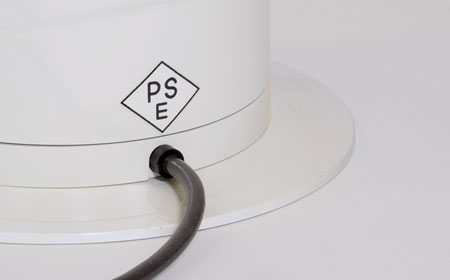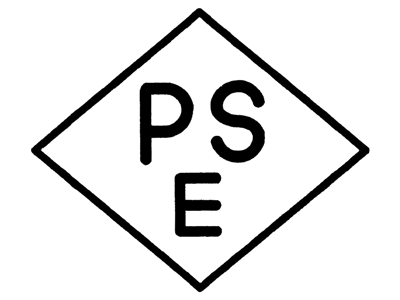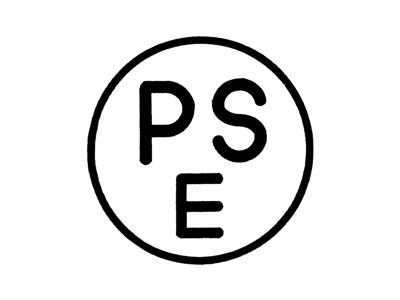Electricity is a very convenient and indispensable part of our lives. On the other hand, electricity can be invisible, making it difficult to notice electrical leakages or high energy. In some cases, improper use can lead to serious accidents, such as fires. To ensure safe use of electricity, this section explains the standards required for power supplies and their safe usage. This Tech Tip is a translation of a Japanese column into English.

What safety standards are required for power supplies?
Power supplies and other electrical equipment must be safe. Therefore, there are laws established to ensure that electrical equipment is safe. In Japan, this corresponds to the Electrical Appliance and Material Safety Law.
The purpose of the Electrical Appliance and Material Safety Law is stated as follows. "to prevent the occurrence of danger and damage from electrical appliances and materials by regulating their manufacture, sale, etc. and by promoting the voluntary activities of private business operators to ensure the safety of electrical appliances and materials."
Electrical equipment must undergo conformity inspections and factory inspections to prove compliance. The Electrical Safety Law divides electrical appliances and materials into two categories: "specified electrical appliances and materials" and "electrical appliances and materials other than specified electrical appliances and materials.
Specified electrical appliances and materials are 116 items, including electric wires, Fuse (electrical), electric heating appliances, etc., that are particularly important for safety among electrical appliances and materials. Non-specified electrical appliances and materials include 341 items, such as electric heaters and light sources. 341 items of electrical appliances and materials other than specified electrical appliances and materials are listed here.
Although "DC power supply equipment" is included in the specified electrical appliances and materials, this applies to AC adapters for consumer use, etc., and does not apply to industrial electrical equipment used inside factories or to parts incorporated into electrical equipment.
Electrical equipment that complies with the Electrical Appliance and Material Safety Law is required to display the PSE mark. PSE stands for "Product + Safety + Electrical appliance & materials. PSE is a standard based on a combination of international standards and Japan's own JIS (Japanese Industrial Standards).


The international electrical standards that PSE refers to are IEC (International Electrotechnical Commission) standards. IEC standards are international standards established by the International Electrotechnical Commission (IEC) in 1906. The IEC is responsible for international standardization in the electrical and electronic fields, excluding the telecommunications field.
Among the IEC standards, power supplies are particularly relevant to IEC 62368-1 (Audio/video, information and communication technology equipment - Part 1: Safety requirements) and IEC 61010-1 ( Safety requirements for electrical equipment for measurement, control, and laboratory use - Part 1: General requirements). The IEC referenced depends on the application of the power supply.
Worldwide Standards
Each country in the world also has its own standards. When electrical equipment is exported to or used in other countries, it must conform to the standards set by each country.
The standards for each of the several countries and regions are as follows
- U.S.A.: UL62368-1, UL61010-1
- Canada: CAN/CSA-C22.2 No.62368-1, CAN/CSA-C22.2 No.61010-1-12
- EU: EN62368-1, EN61010-1
These standards are in accordance with IEC62368-1 and IEC61010-1 set by the IEC.
In addition to the countries listed here, there are also other countries that have their own standards or have adopted ISO. When exporting or using products locally, it is necessary to check the standards of each country.
What is Safety Testing?
Safety tests applied to electrical equipment are tests performed to guarantee the safety of the equipment. Safety tests confirm that the equipment is designed to prevent electric shock and burns, and to prevent secondary damage in the event of a malfunction.
Since these tests are based on international and other national and international safety standards, the content and methods of the tests are also defined by the standards.
Safety testing includes high voltage testing (withstand voltage test), leakage current testing, insulation resistance testing, and ground continuity testing.
Conducting electrical safety testing is a matter of compliance when manufacturing products. It also reduces the risk of costly lawsuits when product users are injured by the product.
In addition to safety tests, there are also tests to determine whether the product is designed to prevent malfunctions caused by noise and other factors. This test is called EMC.
EMC (Electromagnetic Compatibility) has two aspects: EMS (Electromagnetic Susceptibility) and EMI (Electromagnetic Interference). EMS ensures a product does not malfunction when exposed to external electromagnetic radiation, while EMI ensures a product does not emit electromagnetic radiation that could cause other equipment to malfunction.
Matsusada Precision's power supply equipment used for testing to safety standards
AC power source or bipolar power sources are used to verify that electrical equipment complies with standards, such as in safety testing. By using such a power supply, it is possible to reproduce the rated voltage and frequency and simulate abnormal conditions such as momentary power interruption.
In addition, when measuring equipment noise, these power supplies are used to provide a stable current because noise in the power supply to which they are supplied prevents correct measurement.
High-voltage power supplies are also used to test insulation. Insulation testing includes insulation resistance testing and withstand voltage testing (breakdown testing). Apply a certain voltage to the insulated area to measure the leakage current, or apply a high voltage to see if the insulation is destroyed.
Other products include battery charge-discharge cycle test equipment for safety and performance evaluation of battery equipment. Since lithium-ion battery malfunctions can lead to fires and other serious accidents, the regulations are being revised.
Reference (Japanese site)
- CUI INC
https://www.jp.cui.com/blog/the-fundamentals-of-regulatory-considerations-for-power-supplies - COSEL - 安全規格
(https://www.cosel.co.jp/technical/productinfo/0009.html) - 経済産業省 - 電気用品安全法
(https://www.meti.go.jp/policy/consumer/seian/denan/) - 経済産業省 - 情報技術機器の安全性
(https://www.meti.go.jp/policy/consumer/seian/denan/hourei/gijutsukijun/040226-040227_revise/2kou/besshi_163.pdf) - 加美電子 - 【今さら聞けない】安全規格IEC62368とは?その生い立ち
(https://www.kamidenshi.co.jp/magazine/1676/) - HIOKI - 電気安全規格と耐電圧試験・絶縁抵抗試験・保護導通試験
(https://www.hioki.co.jp/jp/products/listUse/?category=35) - TÜV SÜD Japan - 国際的に必須な電気安全要求事項を満足しよう
(https://www.tuvsud.com/ja-jp/services/testing/electrical-safety-testing)


